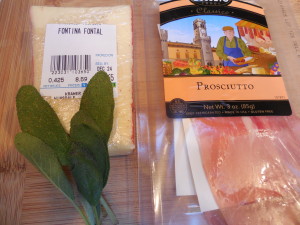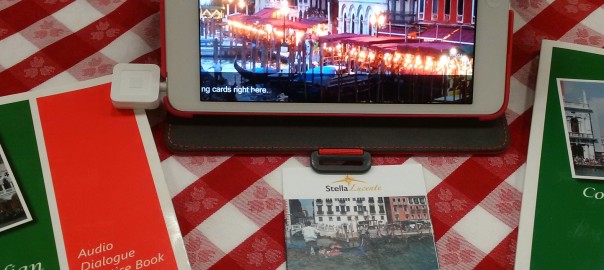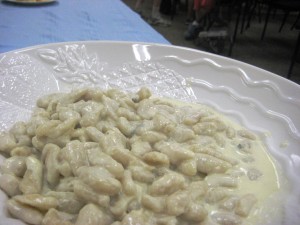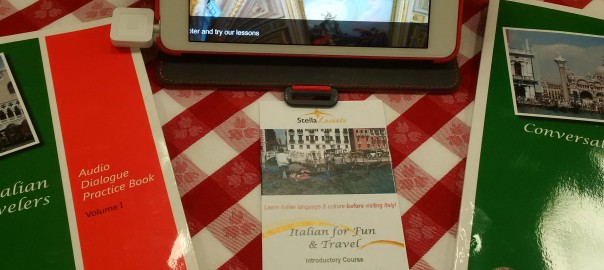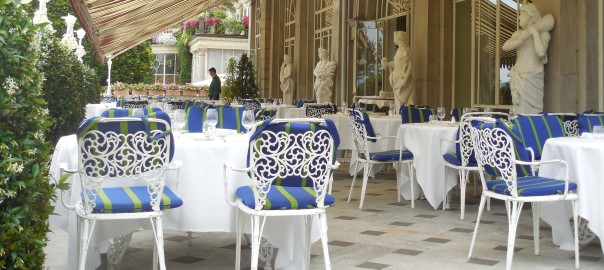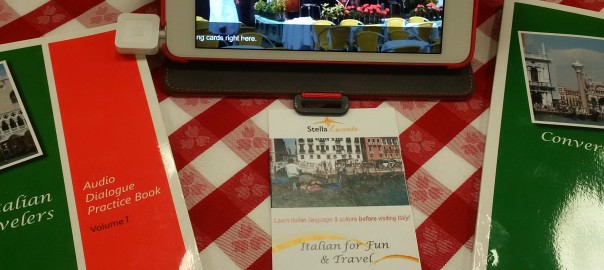 Use our Italian practice tips to write your own Italian email! Revisit the Italian subjunctive mood when writing emails!
Use our Italian practice tips to write your own Italian email! Revisit the Italian subjunctive mood when writing emails!
Can you speak Italian? By now, many of you have passed the beginning stages of learning how to speak Italian and can read and comprehend quite a bit of the language. Meraviglioso!
But have you tried to take the next step to communicate in Italian fluently? Do you know the usual Italian greetings and salutations to use in an email? Can you use the subjunctive mood correctly when writing an email? As everyone knows, email is now an integral part of daily communication all over the world. For Italy, this means that the subjunctive mood is important again in daily life!
For our first Italian practice email using the subjunctive, we will follow the story of Caterina and Francesca, two Italian cousins who are living in different cities and trying to reconnect. Then we will present information about Italian greetings and salutations used in informal and formal types of written communication in Italy. We will describe how to use the verbs trovare, venire, and visitare to describe visiting people and places, how to use the Italian adverb “ci,” and how to make command forms with the verb fare. We will also talk about Italian reflexive verbs of self movement. Finally, we will compare the American and Italian school systems that play such a large part in everyday family life in America and Italy today.
***************************
A note about the Italian subjunctive mood: to express complex feelings in Italian correctly, it is important to use the Italian subjunctive mood. Using the subjunctive mood is difficult for English speakers, because we only rarely use this tense in English, and it’s something that I am always working on! This is the first blog post in the “Italian Practice” series that focuses on how to use the Italian subjunctive mood, or “il congiuntivo,” when writing an email to your family.
To review how to express one’s feelings using the subjunctive mood and how to conjugate the subjunctive mood in the present tense, see our Speak Italian Subjunctive series.
Enjoy the first blog post in this series, “Italian Practice: Emailing Italian Families.”
—Kathryn Occhipinti
Some of this material is adapted from our textbook, Conversational Italian for Travelers © 2012 by Stella Lucente, LLC, found on www.learntravelitalian.com. Special thanks to Italian instructor Simona Giuggioli.
How many phrases that use the subjunctive mood can you pick out of the following emails? Hint: these phrases usually include the word “che.” Look for the underlined phrases for help! And beware those phrases that sound like they should take the subjunctive but do not—these can also be found in the emails below!
Remember these examples as “anchors” in your knowledge for when you try to speak Italian and try out the subjunctive mood in your next Italian conversation!
Italian Practice Email: All about… Family
An Email to Francesca
Cara cugina Francesca,
Dear Cousin Frances,
Quanto tempo è passato da quando ti sei trasferita dall’Abruzzo a Roma!
How much time has passed since you have moved from Abruzzo to Rome!
Spero che tu stia bene.
I hope that you are well.
Spero anche che tuo marito e i tuoi figli stiano bene.
I also hope that your husband and children are well.
È peccato che tu e la tua famiglia vi siate trasferiti cosi lontano da vostra cugina che vi vuole bene.
It is a shame that you and your family have moved so far from your cousin that cares for you all so much.
Come sta la piccola Eleonora?
How is little Eleanor?
Penso che Eleonora debba essere cresciuta molto.
I’m thinking that Eleanor must have grown a lot.
Penso che Eleonora abbia dieci anni, ora, no?
I think that Eleanor is 10 years old, now, no?
Mi sembra che Eleonora debba essere una bella ragazzina ora!
It seems to me that Eleanor must be a beautiful little girl now!
E Giovanni, come sta?
And how is John?
È probabile che Giovanni sia alto e forte e un bravo ragazzo!
I bet that (probably) John is tall and strong and a very good boy!
È incredibile che il tempo passi cosi in fretta!
It’s incredible that the time has passed so quickly!
Si dicono in inglese che “il tempo vola,” e per me è vero!
They say in English that “time flies,” and for me, it is true!
Immagino che tuo marito sia contento con il suo lavoro a Roma.
I imagine that your husband is happy with his job in Rome.
Ma non sono sicura che tu sia felice di vivere là.
But I am not sure that you are happy living there.
Forse tu sei felice di vivere in una città per un po’ di tempo, ma lo so che ti piace molto la campagna.
Maybe you are happy living for a little bit in the city, but I know that you like the country a lot.
Per me, è molto difficile vivere senza di te, mia cara cugina.
For me, it is very difficult living without you, my dearest cousin.
Mi manchi molto!
I miss you so much!
Vorrei che tu venga a trovarmi in Abruzzo quest’estate.
I would like you to come and visit me in Abruzzo this summer.
Pensaci e fammi sapere. Mandami un’email.
Think about it and let me know. Send me an email.
Spero che tu abbia un buon weekend!
I hope that you have a good weekend!
Scrivimi presto!
Write me soon!
Baci e abbracci,
Kisses and hugs,
Caterina
Kathy
Italian Practice Email: All about… Family
A Reply Email to Caterina
Cara cugina Caterina,
Dear Cousin Kathy,
Ero molto contenta di sentire le tue notizie.
I was very happy to hear from you.
La mia famiglia sta molto bene, ed Eleonora e Giovanni sono cresciuti molto in questi due anni che siamo stati a Roma.
My family is very well, and Eleanor and John have grown in these last two years that we have been in Rome.
Eleanora fa il quinto anno di scuola elementare e Giovanni fa il primo anno di liceo.
Eleanor is in the 5th grade, and John is in his first year of high school.
Tutti e due sono bravi figli ed io e mio marito Giuseppe siamo molto orgogliosi di loro.
Both are good children, and my husband Joe and I are very proud of them.
Ho una buona notizia!
I have good news!
Sono libera di viaggiare in Abruzzo quest’estate in agosto per Ferragosto!
I am free to travel to Abruzzo this summer in August for the Ferragosto holiday!
Mi auguro che tu abbia tempo disponibile questo Ferragosto.
I hope that you have time free this Ferragosto.
Tu mi manchi molto, mia bella cugina!
I miss you very much, my beautiful cousin!
Noi siamo certi di avere una buona visita.
We are certain to have a wonderful visit!
Restiamo in contatto e spero di vederti presto!
Stay in contact, and I hope to see you soon!
Ti voglio molto bene.
I care for you very much.
Tanti baci!
Lots of kisses!
Francesca
Frances
Italian Practice: Emailing Italian Families
You Will Need to Know…
Phrases That Take the Italian Subjunctive Mood
Verbs in Italian can have a subjunctive mood that is used to express doubt, uncertainty, desire, or a feeling.
Certain phrases are commonly used to start a sentence in order to introduce the subjunctive mood, and these initial phrases will be in the indicative tense (the “usual” present or past tense). These initial phrases imply uncertainty and trigger the subjunctive mood in the phrase to follow. The phrase that follows will then describe what the uncertainty is about. These introductory phrases usually end with the word che, which means that. Che may also be the ending of the last word used in the introductory phrase!
Note that the simple present or past tenses can also be used after the introductory phrases listed below, rather than the subjunctive mood, if you are speaking about a fact or something that you believe to be true. This use will make perfect sense to the Italian listener, although the subjective mood is also commonly used. Notice that when speaking about the past using these phrases, the imperfetto form of the past tense is usually used.
To review how to express one’s feelings using the subjunctive mood and how to conjugate the subjunctive mood in the present tense, see our Speak Italian Subjunctive series.
Italian Practice: Emailing Italian Families
You Will Need to Know…
Italian Greetings for Family Emails, Texts, and Letters
Now that email has become an essential way to communicate, it is important to know how to address family, friends, and work colleagues in writing. In effect, that old-fashioned way of communicating—the letter—has been resurrected in electronic form! Here are some suggestions for greetings and salutations in Italian, depending on the formality of the situation.
For family and friends, most Italian emails will begin with “Cara,” for females or “Caro” for males, meaning “Dear.” This greeting is, of course, followed by the first name of the person to whom the email is addressed. Because caro is an adjective, the ending can be modified to match the gender and number of the person it refers to, just as other adjectives are. So cara(e) is used before a female singular/plural person(s) and caro(i) before male singular/plural person(s). Carissimo(a,i,e) is a common variation and means “Dearest.” Many times, no greeting at all is used for close family and friends who communicate frequently.
A note about texting, which is even more informal than email, because texts are usually made only to friends: there is much more variation if a greeting is used, and there are many creative ways to greet someone by text in Italian. One of the most common text greetings is probably “ciao” for “hi” or “bye.” There are many common variations, such as “ciao bella” for a female, “ciao bello” for a male, or simply “bella” or “bellezza” for a female, all meaning “hello beautiful/handsome.” If texting in the day or evening, “Buon giorno” or “Buona sera” may be used as well, meaning, “Good morning/Good day” or “Good evening.”
A text is still not acceptable in most situations for a first or a formal communication, although email is now often the preferred way of establishing an initial contact in business.
Italian Practice: Emailing Italian Families
You Will Need to Know…
Italian Greetings for Formal Emails and Letters
Letters are still frequently used in Italy. Several common salutations are used when writing a formal email in Italian. These salutations have been established over many centuries of formal communication.
A formal Italian letter will commonly begin with the Italian word for “Gentle,” which is “Gentile,” followed by a title, such as Mr., Mrs., or Miss, and then a surname. For example: Gentile Signor* Verde or Gentilissima Signora Russo. The Italian word “Egregio,” which used to mean “Esquire,” is still commonly used in very formal business communications, but in these instances, it is translated as “Dear.” “Pregiatissimo” is the most formal type of greeting and is similar to the English phrase “Dear Sir.” This greeting is only rarely used in Italy today.
This all seems simple enough, although a typical formal Italian greeting is often abbreviated and can seem a bit off-putting unless one is fluent in the abbreviations as well. Our salutations above are often written as follows: Gentile Sig. Verde and Gen.ma Sig.na Russo. The table in the next section lists the most commonly used abbreviations.
Also, in Italian, even more than in English, if one holds a professional title, such as “doctor” or “lawyer,” this title is always used as the form of address when speaking and in writing. In fact, those who have attended an Italian university or have an important job title are usually addressed by other Italians as “dottore” or “dottoressa.” A medical doctor is addressed the same way but is known specifically as “un medico” (used for men and women).
Italian Practice: Emailing Italian Families
You Will Need to Know…
Commonly Used Italian Abbreviations for Business Greetings
| Avv. |
Avvocato |
Lawyer |
| Dott. |
Dottore |
Doctor (male or female) |
| Dott.ssa |
Dottoressa |
Female Doctor |
| Egr. |
Egregio |
Dear (Esquire) |
| |
Ingegnere |
Engineer |
| Gent.mi |
Gentilissimi(e) |
Dear (plural) Very Kind |
| Gent.mo |
Gentilissimo(a) |
Dear (singular) Very Kind |
| Preg. |
Pregiatissimo |
Dear |
| Sig. |
Signor |
Mister (Mr.) |
| Sig.na |
Signorina |
Miss |
| Sig.ra |
Signorma |
Misses (Mrs.) |
| Sig.ri |
Signori |
Mr. and Mrs./Messers |
| Spett. |
Spettabile |
Messers |
*When signore is followed by someone’s first or last name, in writing and when addressing someone directly, the “e” from signore is dropped to form signor.
Italian Practice: Emailing Italian Families
You Will Need to Know:
Italian Salutations for Emails, Texts, and Letters
After we’ve written our email, text, or formal letter, how should we sign off? As you can imagine, this is very different depending on how close the two correspondents are. For two friends, the typical spoken salutations, “ciao” and “ci vediamo,” are commonly used for emails and texts, as are the many idiomatic expressions, such as “a presto” or “a dopo.”
For those who are close friends or family, one may send kisses as “baci,” and sometimes hugs, “abbracci,” as we do in English. You can imagine that there are many variations on this theme, such as “un bacione” for “a big kiss.” “Un bacio” or “tanti baci” are other variations and mean “a kiss” and “many kisses.” There is one big difference between salutations in English and Italian, though: Italians normally do not sign off with the word “Love,” as in “Love, Kathy.”
For business, the word “Saluti” is generally used in closing to mean “Regards.” One can also give “Un Saluto” or “Tanti Saluti.” “Cordalimente” means “Yours Truly.” “Cordali saluti” or “Distinti Saluti” are particularly polite, meaning “Kind Regards” and “Best Regards.” “Sinceramente” means “Sincerely” but is not as often used in closing an email or letter.
Commonly Used Familiar Italian Salutations
| Ciao |
Bye |
| Ci vediamo |
Good bye
(Until we see each other again.) |
| A presto! |
See you soon! |
| A dopo! |
See you later! |
| Baci |
Kisses |
| Un bacio |
A kiss |
| Un bacione |
A big kiss |
| Tanti baci |
Lots of kisses |
| Baci e Abbracci |
Kisses and hugs |
Commonly Used Formal Italian Salutations
| Saluti |
Regards |
| Un Saluto |
Regards |
| Cordalimente |
Yours truly |
| Cordali Saluti |
Kind regards |
| Distinti Saluti |
Best regards |
| Tanti Saluti |
Many regards |
| Sinceramente |
Sincerely |
Italian Practice: Emailing Italian Families
You Will Need to Know…
How to Use Trovare, Trovarsi and Visitare
Trovare means “to find” something.
When trovare is combined with the verb andare in the phrase “andare a trovare,” the meaning changes into “to go to visit” someone. An example would be, “Vado a trovare mia mamma,” which of course means, “I go to visit my mother.”
Similarly, when trovare is combined with the verb venire in the phrase “venire a trovare,” the meaning changes into “to come to visit” someone. In the email we have just read, Caterina writes, “Vorrei che tu venga a trovarmi in Abruzzo quest’estate.” She adds “mi” to the end of the verb trovare in order to specify the person who is being visited.
********************
Visitare means to visit or to see a place. For example, “Molte persone visitano l’Italia.” “Many people visit Italy.”
In a formal letter, one might use the phrase, “invitare a visitare,” to invite someone, to be a guest as in, “Vi invitiamo a visitare il nostro blog…” for, ” We kindly invite you to visit our blog.”
*********************
Let’s go back and explore a few more interesting points about the verb trovare. Trovare can also mean “to meet by chance,” or “to run into” someone, as we would say in English. Trovare sometimes means “to think/consider” and is also used to mean “to notice” in some expressions. Trovarsi is a reflexive verb that is used to describe “finding oneself” in certain situations or in a certain place.
| andare a trovare |
to go to visit with/to look in on/to look up |
| venire a trovare |
to come to visit with |
| cercare di trovare |
to try to find |
| trovare per caso |
to happen on/to happen upon/to come across |
| torvare i mezzi |
to find means |
| trovare conforto |
to take comfort |
| trovare informazioni su |
to find information (something) on |
| trovare la propria strada |
to make your way/to take the right road |
| trovare la risposta |
to find the answer |
| trovare la soluzione |
to find the solution |
| trovare il tempo per fare |
to get around to doing something |
| trovare il giusto equilibrio |
to strike a balance |
| trovare (qualcosa) divertente |
to find (something) amusing |
| trovare qualcosa |
to consider something |
| trovare un modo |
to find a way |
| Dove si trova? |
Where is she/he/it located? |
| Si trova in… |
(He/she/it) is located in… |
| Non mi trovo bene con.. |
I don’t get on well with… |
| Troviamoci dopo cena. |
Let’s meet (each other) after dinner. |
Italian Practice: Emailing Italian Families
You Will Need to Know:
How to Use the Italian Adverb “Ci”
The phrases c’è and ci sono mean there is and there are respectively. Ci can also be used to mean here or there when referring to a specific location. The location is either understood by the speakers or will have already have been mentioned in the conversation, and ci will be used in a reply to make the conversation flow more smoothly. In these instances, the location will be introduced by a preposition (a, in, su, da) and ci will replace both the preposition and the place when given in the reply.
Ci is placed before the conjugated verb. With helping verbs dovere, potere, or volere, ci can be placed before the helping verb or attached to the infinitive.
| Non ci voglio più stare. |
(I) don’t want to stay here anymore. |
| |
|
| Vai in pizzeria stasera? |
(Are) (you fam.) going to a pizzeria tonight? |
| No, non ci vado. |
No, (I’m) not going there. |
| Ci sarò. |
I’ll be there. |
| |
|
| Vuoi venire a casa mia? |
(Do) (you fam.) want to come to my house? |
| No, non ci voglio venire. |
No, (I) don’t want to come there. |
| No, non voglio venirci. |
No, (I) don’t want to come there. |
Ci is frequently used as an indirect object to reply to certain questions regarding what someone believes in. “Credere a…?” which means, “Do you believe in…?” is one of the most commonly used phrases of this type. In this case, ci replaces the phrase that is believed in. The meaning of ci would be, “in it” or “about it.”
Ci is also used as an indirect object to reply to certain questions regarding what someone thinks about. “Pensare a…?” can mean, “What do you think about…?” In this case, ci replaces the phrase that is believed in. The meaning of ci would be, “in it” or “about it.”
In other contexts, the verb pensare can be used to ask if someone is going to care of something. The subject pronoun tu will come after the verb in these questions to signify intent. For the response, ci replaces the thing that is being taken care of and the subject pronoun io is placed after the verb to signify intent. The meaning of ci in both cases is, “in it” or “about it.” “Ci penso io,” can always be used when you want to say, “I’ll do it.” or “I’ll take care of it.”
Ci is also used as part of a command in order to ask someone to believe in or think about something that has been stated previously.
| Credi alla religione cristiana? |
(Do)(you fam.) believe in the Christian religion? |
| Si, ci credo. |
Yes, (I) believe in it. |
| |
|
| Pensi di trovare un nuovo lavoro? |
Are you thinking of finding a new job? |
| Si, ci penso ancora. |
Yes, I am still thinking about it. |
| |
|
| Caterina, ci pensi tu a comprare il latte? |
Kathy, are you going to take care of buying the milk? |
| Ci penso io. |
I’ll take care of it. |
| |
|
| Credici! |
Believe in it! (familiar command) |
| |
|
| Pensaci! |
Think about it! (familiar command) |
| |
|
| Ci mancherebbe. |
Don’t mention it. (idiomatic expression) |
Finally, if we want to combine ci with a direct object pronoun in a sentence to say ,“I’ve got it,” or “I’ve got them,” referring to something in our possession, the last letter-i of ci is changed to an e. This is an expression that follows the word order “ce – direct object – verb.” See below for how this works:
| Do you have the ticket in your purse? |
Hai il biglietto nella tua borsa? |
| Yes, I have it in my purse. |
Si, l’ho nella borsa. |
| Yes, I’ve got it. |
Si, ce l’ho. |
| |
|
| Do you have the keys to your car? |
Hai le chiavi alla tua macchina? |
| Yes, I have them. |
Si, ce le ho. |
Italian Practice: Emailing Italian Families
You will need to know:
Common Italian Command Forms with Fare
The verb fare, which means “to do,” or “to make,” often comes up when one person makes a direct request that another person do something. To ask for a favor politely, you could use the (by now, well-known) verb può with fare to make the phrase, “Può farmi un favore?” for, “Could you do me a favor?” But, more often, the familiar command form of this phrase is used; if one is instructing another person to do something, both people often know each other very well. Or, perhaps in the workplace, a superior is making a request of another worker. In this case, the commonly used phrase used would be, “Fammi un favore!” for, “Do me a favor! Piacere also works interchangeably with favore in this expression, as in, “Fammi un piacere!”
Notice that, when attaching an indirect object pronoun (except for gli), direct object pronoun, or a reflexive pronoun to the familiar command verb fa, the first letter of the pronoun is doubled. Below are some commonly used expressions which combine the command form of fare with their pronouns attached.
| Fammi un favore! |
Do me a favor! |
| Fammi un piacere! |
Do me a favor! |
| Fatti vedere! |
Come and see me! (lit. Make yourself seen!) |
| Fatti sentire! |
Call me! (lit. Make yourself heard!) |
| Fallo! |
Do it! |
Fammi can also be used in an idiomatic way, with the meaning, “let me,” when followed by an infinitive verb, such as, “Fammi vedere,” for, “Let me see,” or, “Fammi chiamare,” for, “Let me call.”
| Fammi vedere… |
Let me see… |
| Fammi chiamare… |
Let me call… |
Two additional commonly used familiar commands with indirect object pronouns involve the verbs dire and dare:
| Dimmi! |
Tell me! |
| Dammi! |
Give me! |
Italian Practice: Emailing Italian Families
You Will Need to Know:
Italian Reflexive Verbs for Self-Movement
Italian reflexive verbs can be tricky for the English speaker because there are many situations where reflexive verbs are used in Italian but not in English. In these cases, we must learn to think in Italian! If we think in Italian, using reflexive verbs to refer to where one has moved to or from or to describe a change in one’s feelings does make sense.
We have already talked about the most common reflexive verbs in the second blog post in the Speak Italian! series, Speak Italian: All About… What I Am Doing! This blog post describes activities of daily living, which are the most common activities that use the Italian reflexive verbs.
Other activities of today’s “modern daily living” include interrupting one’s life at a certain location and starting life again in a different location. In this blog post, for instance, one cousin moves from Abruzzo to Rome. It makes sense, then, that the verb for the act of moving oneself is reflexive: trasferirsi, which can mean “to move (oneself) from town to another town” and “to transfer (oneself).”
Following this logic, the more general verbs “to move” (muoversi) or “to stop” (fermarsi) are also reflexive when they refer to an action that is being performed by a person.
Avvicinarsi a (to approach) alontanarsi da (to go away from/distance oneself from) are also included in the table below.
| trasferirsi |
to move (oneself), as in relocate towns; transfer towns or job |
| muoversi |
to move (oneself) from one place to another |
| spostarsi |
to move (oneself) from one place to another, relocate |
| dirigersi |
to go over/head over somewhere |
| avvicinarsi a |
to approach |
| allontarsi da |
to go away from/distance oneself from |
| fermarsi |
to stop (oneself) |
Here is the way this works: if I have moved (myself) from one place to another and want to talk about this, I use the reflexive pronoun for myself (mi) with the conjugated verb for the first person, and then I say where I have moved. If someone else has moved (themselves), and I want to talk about this, I use the other corresponding reflexive pronoun (ti, si, ci, vi, si)/verb conjugation and then the location.
A few pointers are useful to remember.
When talking about a move we have made, we will be speaking in the past tense and will need to use the passato prossimo past tense verb form for this one-time event. All reflexive passato prossimo verbs use essere as the helping verb with the past participle. Females will need to change the passato prossimo ending from an “o” to “a” when referring to themselves.
Also, remember to leave out the subject pronoun (io, tu, Lei/lei/lui, noi, voi, loro) unless it is necessary for clarification.
Finally, remember how to use prepositions when talking about a location—“a” for cities and small islands and “in” for countries, regions, states in the United States, and large islands like Sicily.
All of this is easier than it sounds once you give it a try!
Mi sono trasferito(a) a New York.*
I moved/have moved to New York City.
Ti sei trasferito(a) nello stato di New York due anni fa, corretto?
You moved/have moved to New York State two years ago, correct?
Lui si è trasferito in America la settimana scorsa.
He moved/has moved to America last week.
Lei si è trasferita in America la settimana scorsa.
She moved/has moved to America last week.
Ci siamo trasferiti a Roma per un lavoro molto importante.
We transferred/were transferred to Rome for a very important job.
Vi siete trasferite alla scuola di Marymount Internazionale a Roma.
You all (girls) transferred/have transferred to the Marymount International School in Rome.
Loro si sono trasferiti in Italia per la loro società.
They transferred/have transferred to Italy for their company.
Finally, it should be noted that there are other ways of describing a person’s move from one place to another that do not involve reflexive verbs. To emphasize that one has moved from an old house to a new one, the phrase cambiare casa is used. To describe moving furniture from one’s old house to the new house (i.e., to move things), the nonreflexive verb traslocare is used.
The Italian school system is similar to the U.S. school system. School years are divided into primary, middle, and secondary, or “high” school years. College is referred to as “university,” and in the past, a “university degree” entailed 6 years of education, similar to a master’s degree in the United States. Some 4-year university degrees are now also available in Italy. Below is a comparative list of the American and Italian school systems with the number of years children spend in each level.
American and Italian School Systems
| U.S. School |
Years |
Italian School |
Years |
|
|
|
|
| Primary school |
6 |
Scuola Elementare/la prima elementare |
5 |
| Middle school |
2 |
Scuola Secondaria/Scuola Media/la prima media |
3 |
| High school |
4 |
Liceo/il primo liceo |
5 |
For elementary school, if a child is in the 1st through 5th years of school:
Anna va alla scuola elementare.
Anna goes to the grade school.
Anna è in prima (classe) elementare. (seconda, terza, quarta, quinta classe)
Anna fa il primo anno di scuola elementare. (secondo, terzo, quarto, quinto anno)
Anna is in the first year/1st grade of elementary school. (second, third, fourth, fifth year/2nd, 3rd, 4th, 5th grade)
For middle school, if a child is in the 6th through 8th years of school:
Anna va alla scuola secondaria. or Anna va alla scuola media.
Anna goes to junior high school. or Anna goes to middle school.
Anna è in prima (classe) media. (seconda, terza classe)
Anna fa il primo anno di scuola media. (secondo, terzo anno)
Anna is in the first year/6th grade of middle school. (second, third year/7th, 8th grade)
For high school, if a child is in the 9th through 13th years of school, we can use similar phrases. Notice that there is no special title like “freshman, sophomore, junior, senior” for high school.
Anna va alla scuola superiore. or Anna va al liceo.
Anna goes to high school.
Anna è in prima (classe) liceo. (seconda, terza, quarta, quinta classe)
Anna fa il primo anno di liceo. (secondo, terzo, quarto, quinto anno)
Anna is in the first year/9th grade of high school. (second, third, fourth, fifth year/10th, 11th, 12th, 13th grade)
-Some of this material is adapted from Conversational Italian for Travelers, © 2012 by Stella Lucente, LLC.
 Kathryn Occhipinti, MD, is the author of the
Kathryn Occhipinti, MD, is the author of the
Conversational Italian for Travelers series of books and a teacher of Italian for travelers to Italy in the Peoria and Chicago area.
“Everything you need to know to enjoy your visit to Italy!”
Join my Conversational Italian! Facebook group and follow me on Twitter at StellaLucente@travelitalian1 and start to learn Italian today for FREE!
Conversational Italian! Facebook Group
Tweet @travelitalian1 for Stella Lucente Italian
YouTube videos to learn Italian are available from © Stella Lucente, LLC.
Learn Conversational Italian.
More information on and photographs of Italy can be found on Facebook Stella Lucente Italian and Pinterest Stella Lucente Italian.
Facebook Stella Lucente Italian
Pinterest Stella Lucente Italian
Visit learntravelitalian.com/download.html to purchase/download Conversational Italian for Travelers and find more interesting facts and helpful hints about getting around Italy! Learn how to buy train tickets online, how to make international and local telephone calls, and how to decipher Italian coffee names and restaurant menus, all while gaining the basic understanding of Italian that you will need to know to communicate easily and effectively while in Italy. —From the staff at Stella Lucente, LLC
Italian Subjunctive Mood Practice: Emailing Italian Families
Ripieno—The word for “stuffed” in Italian. And pork chops filleted and filled with prosciutto and Fontina cheese can only mean—delicious!

